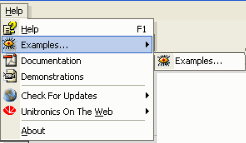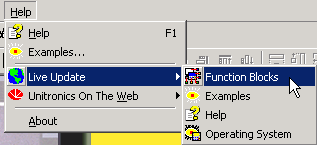Getting Started With VisiLogic
If you are new to VisiLogic, please start with this manual. Here, you can learn the basics of the VisiLogic software environment.
These concepts are important even if you have experience programming other controllers. The subjects introduced here are covered in depth in the VisiLogic Software Manual Series.
The Series includes the following manuals in pdf format:
-
VisiLogic: Getting Started
This provides a general overview of the VisiLogic environment, Hardware Configuration, Controller Settings, Remote Access, Utilities, and Tools, as well appendices on Troubleshooting and Vision Controller Divisions
-
VisiLogic: Ladder Application Programming
Includes a section on Getting Started with Ladder, as well as separate sections on program calls and Ladder functions.
-
VisiLogic: HMI Application Programming
-
VisiLogic: Communications
-
VisiLogic: Utilities
VisiLogic Overview
VisiLogic is the software tool you use to create control projects for Vision controllers.
After you plan the control task, use VisiLogic to write, debug, and download the control and applications into the controller.
The PLC application is your control, or automation application. You write the PLC application using the Ladder Editor.
The HMI application configures the operating panel's function. You use the HMI Editor to create the Displays that are shown on the controller's screen.
Displays tell your operators what to do. You can have your operators log in with a password, enter setpoints and other data, and instruct the operator what to do in case of a system problem or alarm. A Display can contain both text and images. Text and images can be both fixed and/or variable.
Variables are inserted into a Display to:
-
Show run-time values as integers
-
Represent run-time values with either text, images, or bar graphs
-
Show text messages that vary according to runtime conditions
-
Enable an operator to enter data using the Vision's alphanumeric keypad
Editors
You use different editors to create your control project:
Each editor is operated through a different window. You switch between the editors via the Toolbar buttons or by clicking elements in the Project Explorer.
Language Interface
VisiLogic supports a number of interface languages. You can change the interface language by selecting Languages from the VisiLogic View menu.
Hardware Configuration
VisiLogic offers an integral module. The foundation of a Vision control system is the controller. The Snap-in I/O Module provides an on-board I/O configuration. You add I/Os by integrating I/O Expansion Modules.
After you select the or modules connected to the controller, you can configure inputs: , , and and ; and outputs: , , and .
Ladder Modules and Subroutines
VisiLogic is a modular program that you build using Modules and Subroutines.
Operand View and Watch Folders
VisiLogic allows you to and their contents according to type and whether or not they are in use. You can also group related operands according to functions in .
Vision Controller Divisions
There are two major Vision divisions, Standard and Enhanced. Each division supports different HMI features and Ladder functions.
For more information, refer to Appendix B: Vision Controller Divisions.
VisiLogic Examples
|
When you install VisiLogic, an Examples folder is created on your hard disk, containing field-tested VisiLogic (.vlp) sample applications. You can copy these sample applications and adapt them for your own use--if, for example, an application is written for the V120, you can select the V230 via Hardware Configuration.
|

|
Help Forums
The Unitronics forums are located at http://forum.unitronics.com/.
Note that you can search the forums without subscribing, but that you must subscribe in order to post a question.
Help
Use the VisiLogic Help System to learn how to use the software and answer your questions. The VisiLogic Software Manuals are based on content from the Help system, and are intended for users who prefer to learn from printed documentation.
However, please note that the Help system always contains the most updated content.
Live Update from the Web
Live Update is available from the Help menu. To start Update, select a subject and follow the on-screen instructions.

|
Note ♦
|
After downloading FBs, you must close and then restart VisiLogic. The new FBs will appear on the FBs menu. Check the topic FB Library for more information.
|
|
♦
|
After downloading a new Operating System to your PC, you must install it in the controller. Connect the controller to your PC, then open Communication and OS from the Connection menu. The new Operating system will appear in the Install Operating System tab. Select Download to begin the installation process.
|

